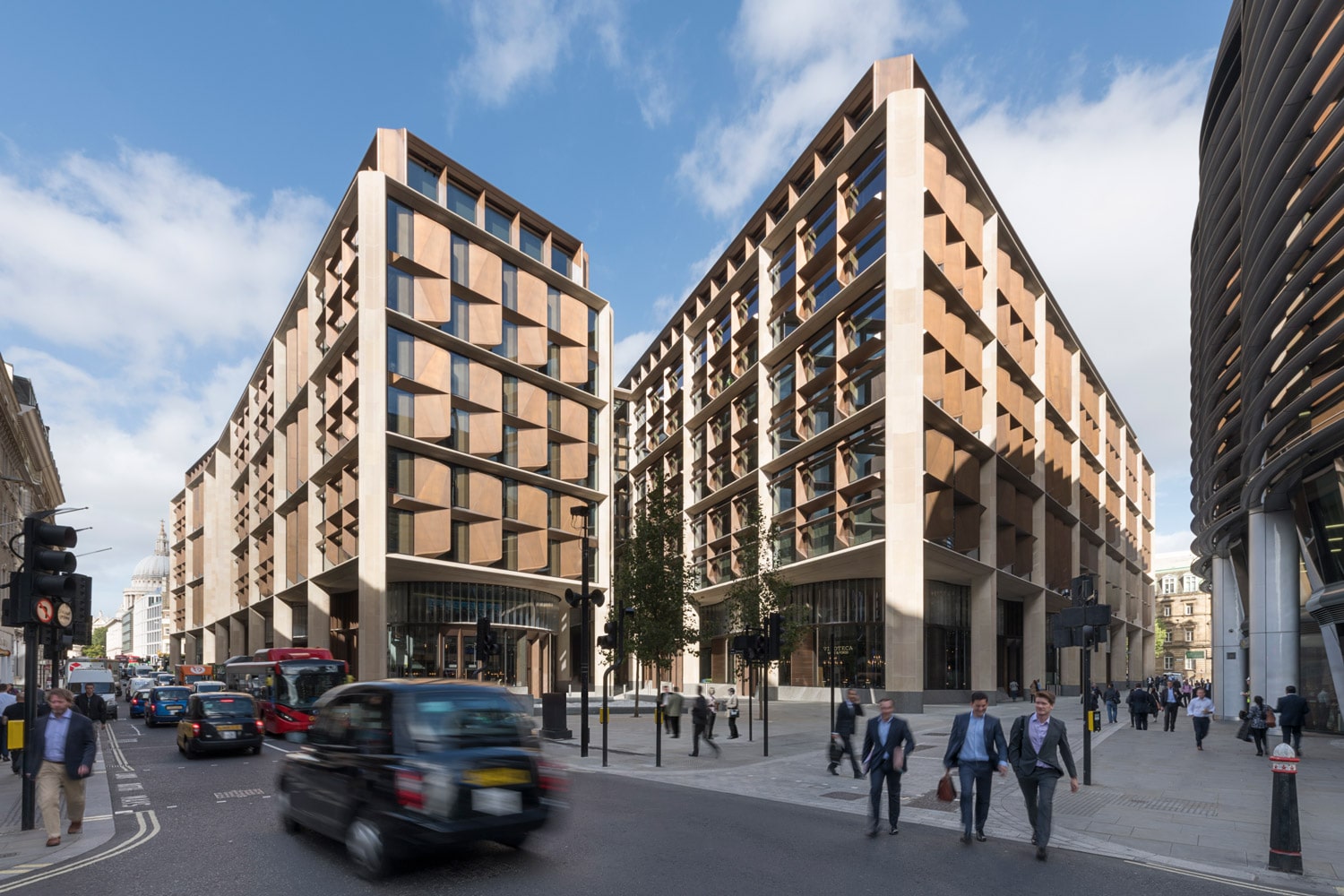Story at a glance:
- Smart building facades are capable of responding—either passively or actively—to changing environmental conditions.
- The main benefit of smart building facades is their ability to reduce both energy consumption and operational expenses.
- Electrochromic glass, dynamic shading devices, and thermochromic glass are all examples of smart building facades.
Often the first part of a building you see, the facade is both a building’s first line of defense against the elements and a manifestation of its character. “A facade is far more than the protective shell of a building. Its design not only characterizes the building itself but also influences the urban environment,” Lisa Burling, national sales manager at Agrob Buchtal, previously told gb&d.
Facades are also highly influential when it comes to creating comfortable interior environments, as they are where the bulk of thermal heat gains and losses occur. It is only right, then, that facades be equipped with technology that allows them to respond and adapt to the environmental conditions they routinely face.
In this article we’ll take an in-depth look at the evolving world of smart building facades.
What is a Smart Building Facade?
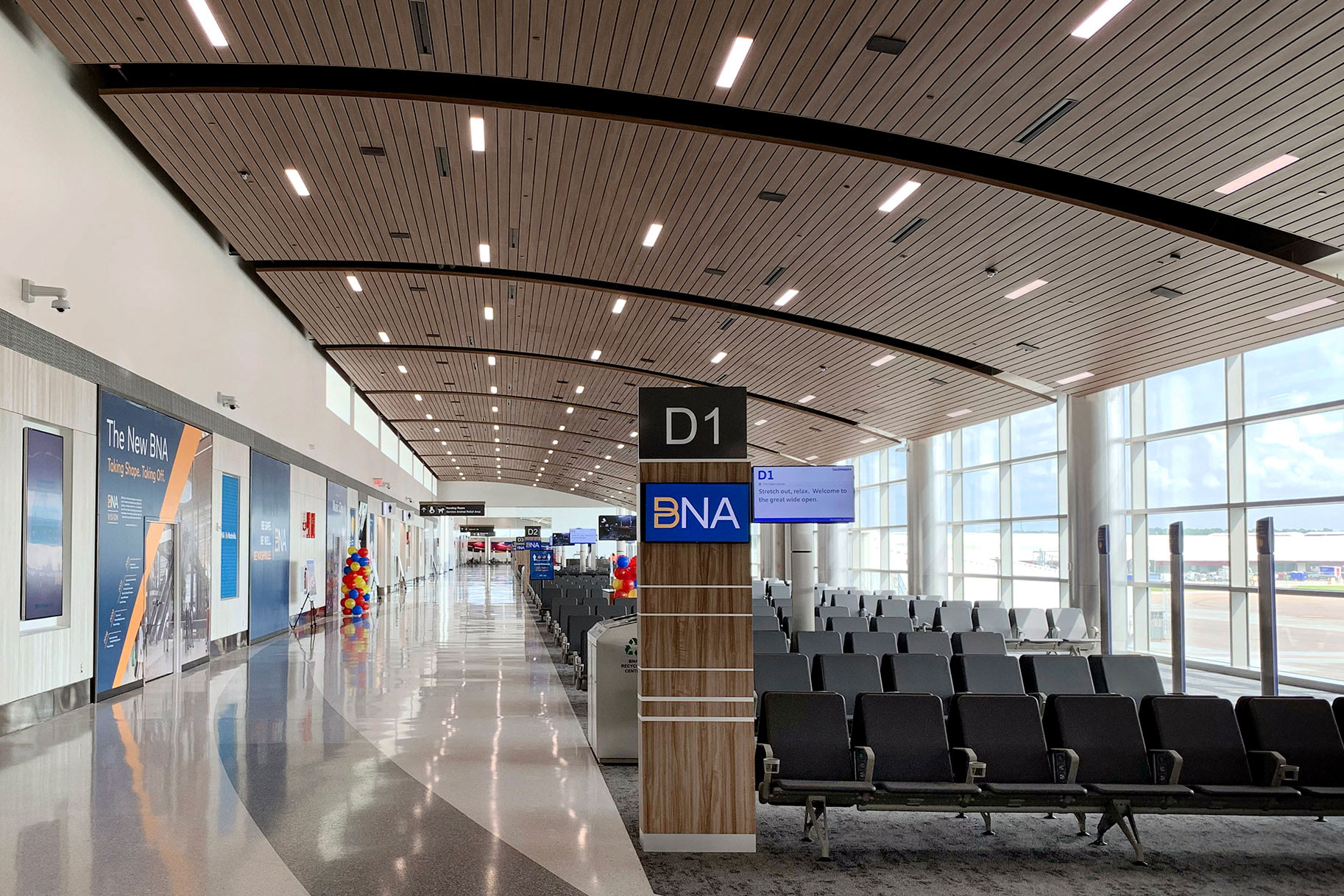
The new Concourse D expansion at the Nashville International Airport features a smart building facade made up of electrochromic glass, which uses an electrical voltage to instantly switch between clear and tinted. Photo courtesy of Fentress Architects
Also known as intelligent or responsive facades, smart facades refer to those facades that have been intentionally designed to respond to environmental conditions and adapt or transform themselves accordingly. Essentially a smart facade is any facade that is not static but changes throughout the day or throughout the year. These changes are usually visible to the naked eye, though some may be much more subtle than others.
Smart facades are most commonly used to maximize the admittance of natural sunlight while at the same time protecting against unwanted UV exposure and solar heat transfer into the building’s interior, though they can also be used to facilitate natural airflow or for privacy to prevent people from looking in.
And while the benefits of smart facades vary depending on their function, they are largely favored for their ability to reduce energy consumption and lower a building’s operating costs. Secondary benefits may include increased privacy and/or improvements to a structure’s aesthetic quality.
Types & Examples of Smart Building Facades
There are two overarching groups that smart building facades may fall into—passive or active.
Passive Smart Facades

The Footprint Center in Phoenix emphasizes sustainable design strategies, including a kinetic metal panel facade. Photo by Christy Radecic
A passive smart facade is capable of responding to environmental conditions via external stimuli alone, requiring no electronics or mechanized components. Passive smart facades are favored for their net zero contribution to a building’s energy consumption and operational emissions, making them ideal for regenerative and climate responsive construction projects.
Photochromic Glass Facades
Akin to transition lenses that are capable of switching between conventional eyeglasses and sunglasses, photochromic glass facades automatically change from clear to tinted when exposed to UV light.
This is done by embedding microcrystalline silver halides (silver chloride) within the glass substrate itself. When the facade is exposed to UV-A light (wavelengths 320 to 400 nm), the electrons from the glass combine with clear silver cations to create elemental silver. Unlike silver cations elemental silver is visible, so the glass appears darker, blocking UV rays and reducing solar-induced heat.
Alternatively, a plastic photochromic film may be adhered to the glass, in which case the chemical process is a bit different. These films use organic photochromic molecules like naphthopyrones or oxazines to produce the reversible darkening effect.
Thermochromic Glass Facades
Thermochromic smart facades are similar to photochromic facades, but instead of darkening upon exposure to sunlight they use a phase-changing polymer to passively adjust the glass’s opacity or transmittance level once it reaches a certain temperature (hence the “thermo-” prefix).
Buildings that employ this type of smart facade feature glass panes or windows with a thin thermochromic film, of which normally exists in an initial monoclinic (cold) state at lower temperatures. When in this cold state the film is less reflective and behaves as a semiconductor, allowing both visible and near-infrared (NIR) radiation to enter the building. Once the temperature reaches a certain point, the thermochromic film then enters its rutile (hot) state and becomes opaque, whereupon it begins to act like a semi-metal, reflecting a wider range of NIR radiation and minimizing solar heat gain.
Self-Cleaning Glass Facades
It may sound like science fiction, but self-cleaning glass facades exist. These smart facades are coated with a transparent coating of hydrophilic and photocatalytic minerals during manufacturing that allows them to make effective use of rainwater and UV rays for self-cleaning purposes.
Exposure to UV radiation during the day triggers the decomposition of organic particulates and makes the glass surface hydrophilic. When rain (or any water, for that matter) comes into contact with the glass, it forms a thin layer and rinses off the accumulated dirt and mineral materials. Predictably, the main benefit of such a facade is the positive impact it has on a building’s maintenance costs, reducing maintenance-related expenses by approximately half.
Thermally Reactive Shaders
Many passive smart facades involve glass—and specifically glass that changes its appearance upon stimulation—but there are also smart facades that employ passive solar shading devices as a means of controlling UV exposure and solar heat gain in glass-fronted buildings.
Researchers at the Fraunhofer Institute for Machine Tools and Forming Technology IWU in Dresden—in collaboration with the Weissensee School of Art’s Department of Textile and Surface Design—for example, have developed a flower-shaped thermally reactive shading device whose fabric petals each contain integrated shape-memory actuator wires made from a nickel-titanium alloy. This alloy may be bent into any shape but, upon exposure to heat, will return to its original shape.
When installed along a building’s facade the petals of each flower—bent into a closed position—unfurl to varying degrees as the wires inside them are heated by the sun, shielding the glass and reducing solar gain. Once the sun starts to set the petals close as the wires cool and return to their bent position.
Kinetic Wind Facades
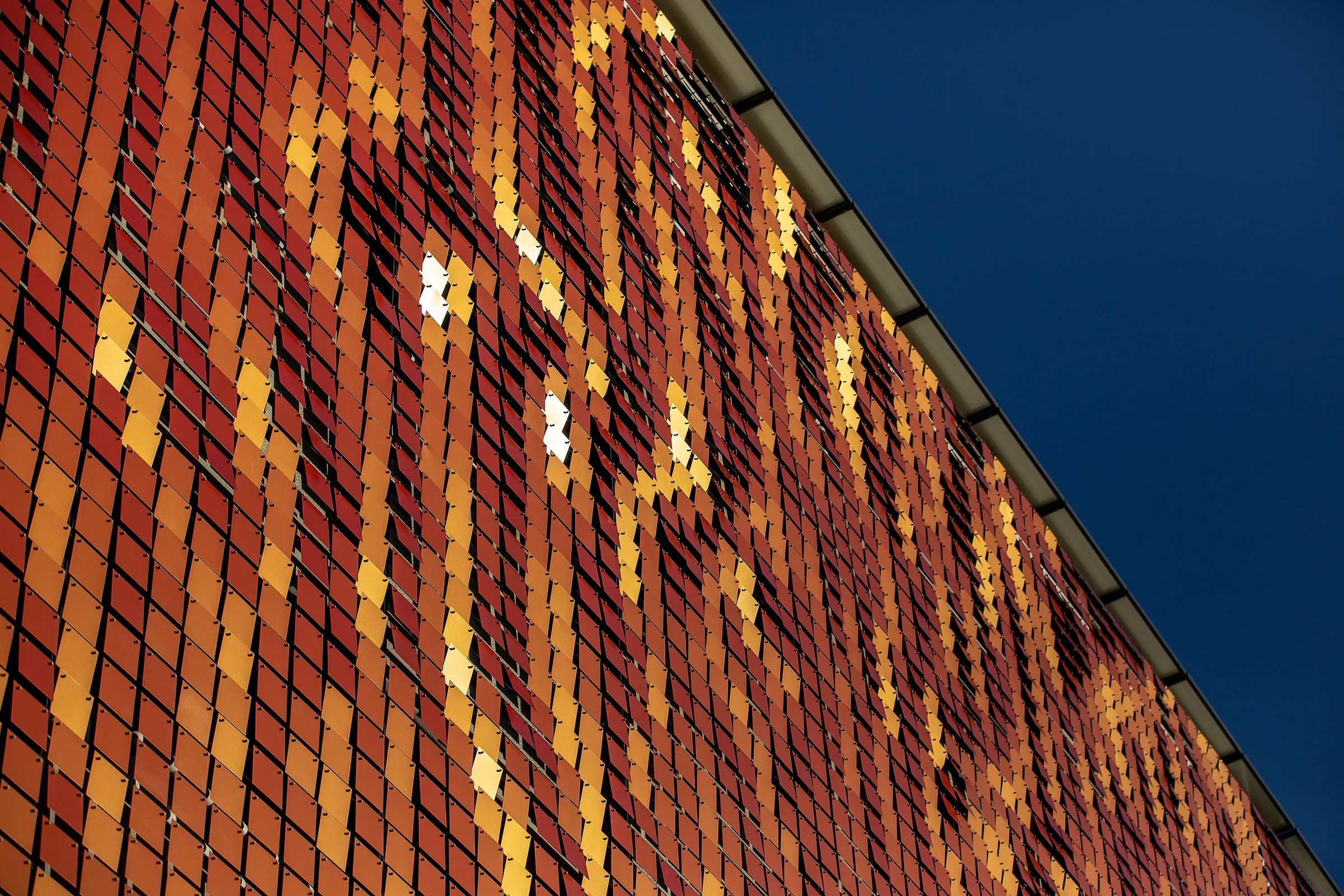
The 298,000-square-foot Footprint Center stadium project is eye-catching to onlookers, covered in metal flaps that move in the wind. Photo by Christy Radecic
While it’s true that most smart facades are engineered with the intent of reducing operational costs, some—like kinetic wind responsive facades—serve an aesthetic purpose.
The HOK-designed Footprint Center in Phoenix is immediately recognizable and eye-catching thanks to its facade of 130,000 hinged metal panels that move with the wind. “The building has this kinetic energy as it transitions throughout the day because the flaps move with the wind,” Devin Norton, senior project designer for HOK, previously told gb&d. The metal uses a special color-shifting paint that is especially dynamic, he says, and the changing light and wind cause the building to appear in shades of deep red, yellow, and even white. “It’s a representation of wind through metal.”
Active Smart Facades
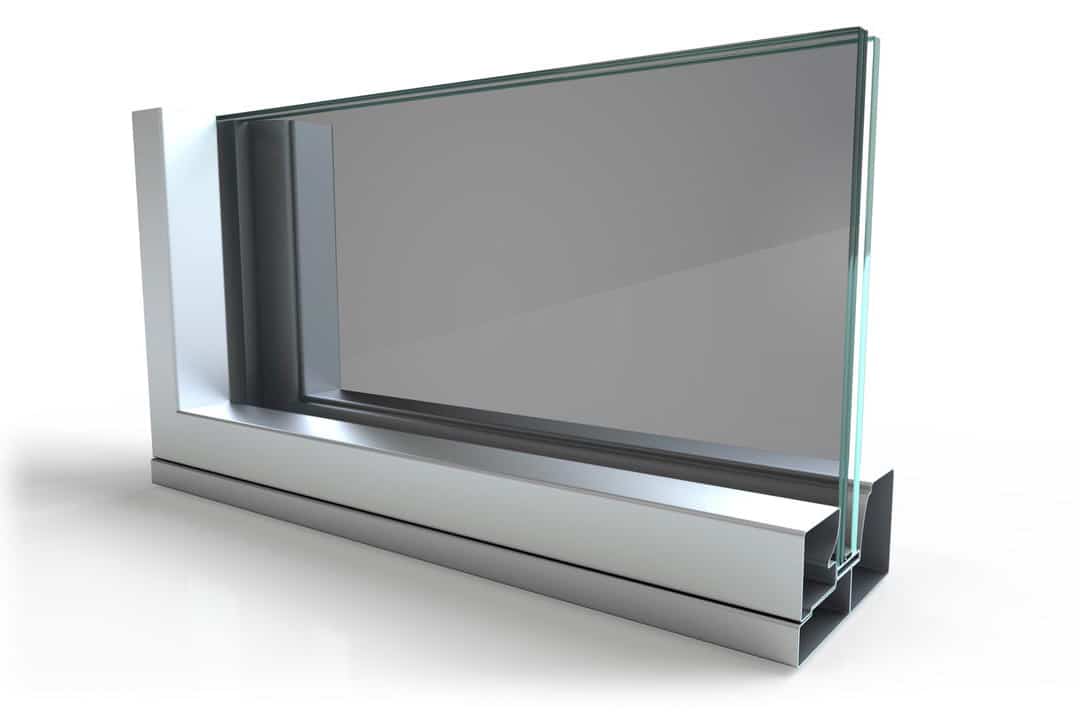
Kinestral’s Halio Smart-Tinting Glass is controlled through an app. Photo courtesy of Kinestral
Active smart facades, on the other hand, are controlled by an electronic or mechanized system and require intentional input from an authorized user.
Dynamic Shading
While passive thermally responsive shaders exist, facades that employ computerized or motorized dynamic shaders seem to be more popular. These facades use electronically controlled solar shading devices that may be opened, shut, angled, rotated, or otherwise manipulated to carefully control the amount of solar energy entering a building throughout the day.
Facade-mounted dynamic shading devices are often linked to some manner of building automation system and may use sensors or cameras to automatically adjust to changing sunlight levels. Alternatively, dynamic shading devices may be controlled via an app, allowing individual users to have greater control over their indoor environmental conditions.
Abu Dhabi’s Al Bahar Towers, for example, makes use of dynamic shaders in the form of screened curtain walls inspired by the mashrabiya—a traditional Islamic lattice shading device—that are composed of triangular actuated panels. Each triangle is coated with fiberglass and has been electronically programmed to respond to the sun’s movement in order to reduce glare and solar heat gain. The unique shape of the panels ensures that they remain useful throughout the year regardless of the sun’s current angle.
Electrically Switchable Glass
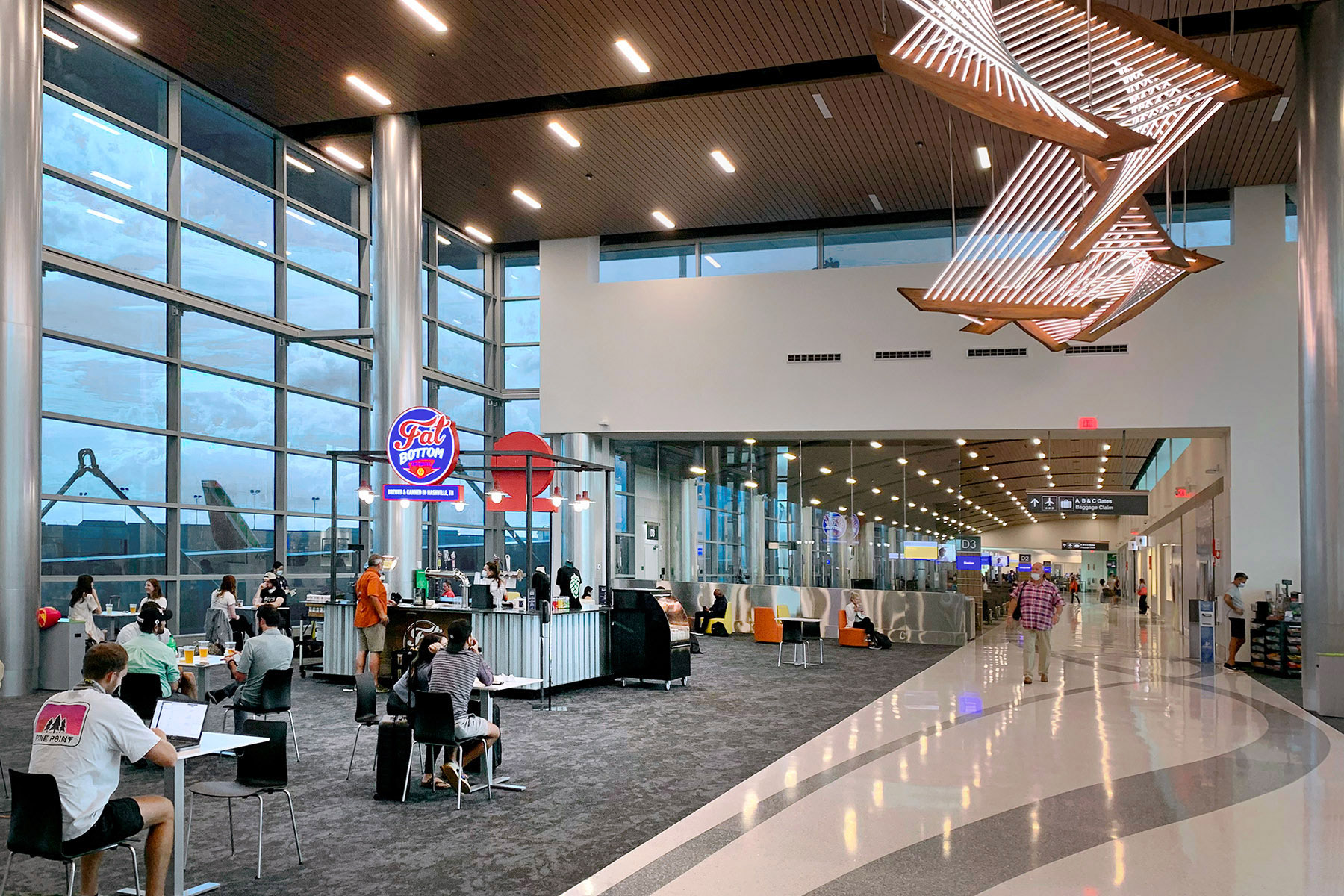
Nashville International Airport’s new Concourse D one of only five LEED v4 Silver airport facilities in the US and makes use of an electrochromic glass facade from SageGlass. Photo courtesy of Fentress Architects
Electrically switchable smart facades use either micro-blinds, polymer-dispersed liquid-crystal devices (PDLCs), suspended-particle devices (SPDs), or electrochromic devices to actively adjust the tint or opacity of the glass when an electric charge is applied.
- Micro-blinds. Feature microscopic rolls of thin metal blinds on glass; when no voltage is applied, the blinds are rolled and thus let light through; when a voltage is applied, the blinds unroll and prevent light from entering.
- PDLCs. Created by dissolving liquid crystals within a liquid polymer and letting the polymer cure into a solid, at which point the liquid crystals become incompatible with the polymer and form droplets; when no voltage is applied, the crystals are randomly arranged in the droplets and scatter light, creating an opaque surface; when voltage is applied, the crystals align and light is allowed to pass through the droplets undisturbed, resulting in a transparent sheet of glass.
- SPDs. Consist of a thin film laminate of rod-like nano-scale particles suspended in a liquid placed between two panes of glass; when no voltage is applied, the particles are randomly organized and thereby serve to block and absorb light; when a voltage is applied, the molecules then align and let light through.
- Electrochromic. Typically include several thin layers of a ceramic material that are then charged with a large number of lithium ions; when a voltage is applied, the lithium ions and electrons are transferred between layers, resulting in an instantaneous tinted effect; once voltage is shut off, the glass becomes clear again.
Of these various types of electrically switchable smart facades, electrochromic glass is perhaps the most common in modern architecture. HALIO, formerly Kinestral Technologies, is a leader in electrochromic glass technology and developer of the HALIO Smart Glass family of products. Aside from the glass itself, the complete HALIO autonomous system includes tint drivers (which control each window’s tint level), the HALIO Sky Camera (records and reports changes in daylight levels for automatic adjustment), the HALIO Cloud (controls system automation), and HALIO Gateway, which securely manages all communication between HALIO devices and the HALIO Cloud.
SageGlass—a brand under the Saint-Gobain family of companies—is another industry leader in electrochromic smart glass technology. Fentress Architects utilized SageGlass Classic—amongst other energy-efficient features—when designing the Nashville International Airport’s Concourse D and Terminal Wing expansion, helping the project to earn LEED Silver certification.
Active Ventilation Facades

Bloomberg’s European headquarters, designed by Foster + Partners, employs an active ventilation facade that helps facilitate natural airflow during the Spring and Autumn months. The vertical bronze fins along the exterior walls may be opened, allowing air to funnel into the building’s deep-plan floor plates and rise up and out into the central atrium. Photo by Nigel Young
Some smart facades are intended to improve ventilation and consist of windows, panels, or vents that may be opened via user input or automatically at the behest of a central building automation system—essentially allowing a building to “breathe” throughout the day.
The northern building of Bloomberg’s European headquarters in London was designed by Foster + Partners in collaboration with Wirth Engineering and Breathing Buildings to include a breathable facade that facilitates natural ventilation during the spring and autumn mid-seasons.
The facade consists of vertical bronze fins lining the building’s exterior walls, each of which incorporates an acoustically treated vent that may be opened or closed to control airflow. All air that enters in this manner is funneled to the building’s expansive deep-plan floor plates, rising up and out of the central atrium to ventilate the interior.
“People respond better to environments that change, that ebb and flow with the temperature and sounds and light,” Michael Jones, project architect and senior partner at Foster + Partners, previously told gb&d. “The breathable walls are like opening a window at home. You feel better. It’s the same kind of effect on a much larger scale.” When temperatures dip into the extremes during the summer and winter months, the smart facade’s vents are sealed off and the building switches to a mechanical ventilation system.

